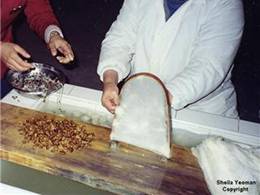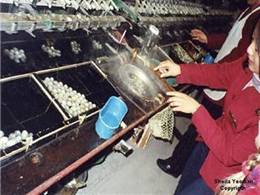
‘Silkworm’ is the term given to the silk-producing larvae of any several species of moth. Silkworms secrete a fluid which solidifies on contact with sir into a thread that the larvae use to spin around themselves to form a cocoon. In nature, the cocooned larvae develops into a moth who emerges from the coco between 10 to 16 days later. On silk farms, however, the larvae never get a chance to develop into an adult moth. In China and Japan, silkworms have the thread from their cocoons reeled mechanically. To prevent the silkworm pupae from eating through their cocoons and damaging the silk threads, they are killed by immersion in boiling water, steaming, drying in an oven, electrocution or being micro-waved (1). The thread is then reeled. In Thailand, silk is hand reeled from Thai moth cocoons containing the live pupae. The cocoons are placed in almost boiling water to loosen the end of the thread for reeling. The pupae inside are frequently eaten by the workers. Approximately 3,000 silkworms die to make every pound of silk (2). The production and wearing of silk and silk products causes the death and suffering of millions of silkworms. In addition, insects are not only the victims of the demand for silk-like products. The military and medical communities are leading experiments on hamsters, cows and goats in an attempt to synthesize particular proteins to make a fabric that could replace Kevlar (3), a synthetic fabric that forms planar sheet-like structures a lot like silk-protein. Milk that contains silk proteins, used in fibers sold under the name “bioSteel” (4,5), has been produced by transgenic cloned goats. The company’s president says that he intends to keep a herd of “several thousand animals” to generate the silk (6).
|
|
 |
 |
|
To make batting, cocoons are soaked, which kills the worms. The worms are then removed, and the cocoons are stretched over a hoop . Silk factory in Souzhou, China, February 2005 |
Worms being boiled to loosen the cocoons so that they can be unraveled to make thread. Silk factory in Souzhou, China, February 2005 |
|
WHAT YOU CAN DO! When shopping, choose humane alternatives to silk ties and other items ; nylon, polyester, tencel, milkweed seed-pod fibers, silk-cotton tree and ceiba tree filaments, and rayon. These alternatives are easily available online and in stores.
References: (1) Ron Cherry, Sericulture, Bulletin of the Entomological Society of America, 35 (1993): 83-84. (2) Eric. A Wong, Silkworms produce human type III pro-collagen, ISB News Report, Feb. 200. (3) Man-made spiders silk, Materials World, 10 (2002): 26-28. (4) Stephen Wilingham, Scientists Weave Spider Silk into New Bullet Proof Vests, National Defense, Sep. 2000. (5) Edward Atkins, Silk’s Secrets, Nature, Aug 28, 2003. (6)Stephen Wilingham, Scientists Weave Spider Silk into New Bullet Proof Vests, National Defense, Sep. 2000. |
|
|
|